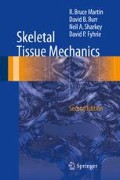Abstract
This chapter describes how engineering principles can be used to estimate joint forces. Principles of static and dynamic analysis are reviewed, with examples of static analysis applied to the hip and elbow joints and to the analysis of joint forces in human ancestors. Applications to indeterminant problems of joint mechanics are presented and utilized to analyze equine fetlock joints.
…mechanical science is of all the noblest and most useful, seeing that by means of this all animate bodies which have movement perform all their actions…
Leonardo Da Vinci (1452–1519)
Access this chapter
Tax calculation will be finalised at checkout
Purchases are for personal use only
Notes
- 1.
- 2.
In this chapter, vector quantities are represented in bold type and scalars (such as vector magnitudes) in ordinary type.
- 3.
P1 is also called the pastern bone. The name apparently comes from the fact that to pasture a horse without benefit of fences, ranchers would hobble it with a short rope connecting the P1 bones.
References
Agur AMR. Grant’s atlas of anatomy. Baltimore: Williams & Wilkins; 1991.
Alexander RM. Animal mechanics. Seattle: University of Washington Press; 1968.
Atwater AE. Gender differences in distance running. In: Cavanaugh PR, editor. Biomechanics of distance running. Champaign: Human Kinetics Books; 1990.
Barbenel JC. The biomechanics of the temporomandibular joint: a theoretical study. J Biomech. 1972;5:251–6.
Bartel DL, Schryver HF, Lowe JE, Parker RA. Locomotion in the horse: a procedure for computing the internal forces of the digit. Am J Vet Res. 1978;39:1721–33.
Bay BK, Hamel AJ, Olsen SA, Sharkey NA. Statically equivalent load and support conditions produce different hip joint contact pressures and periacetabular strains. J Biomech. 1997;30:193–6.
Bergmann G, Graichen F, Siraky J, Jendrzynski H, Rohlmann A. Multichannel strain gauge telemetry for orthopaedic implants. J Biomech. 1988;21:169–76.
Bergmann G, Graichen F, Rohlmann A. Hip joint loading during walking and running measured in two patients. J Biomech. 1993;26:969–90.
Bergmann G, Deuretzbacher G, Heller M, Graichen F, Rohlmann A, Strauss J, Duda GN. Hip contact forces and gait patterns from routine activities. J Biomech. 2001;34(7):859–71.
Borelli GA. On the movement of animals (1989 translation by P. Maquet). Berlin: Springer; 1989.
Burr DB, Gerven DPV, Gustav BL. Sexual dimorphism and mechanics of the human hip: a multivariate assessment. Am J Phys Anthropol. 1977;47:273–8.
Charnley J. Arthroplasty of the hip: a new operation (reprinted from Lancet, pp. 1129–1132, 1961). Clin Orthop Relat Res. 1973;95:4–8.
Collins JJ. The redundant nature of locomotor optimization laws. J Biomech. 1995;28:251–67.
Davy DT, Kotzar GM, Brown RH, Heiple KG, Goldberg VM, Heiple JG, Berrile J, Burstein AH. Telemetric force measurements across the hip after total arthroplasty. J Bone Joint Surg. 1988;70A:45–50.
English TA, Kilvington TM. In vivo records of hip loads using a femoral implant with telemetric output. J Biomed Eng. 1979;1:111–5.
Erdemir A, Piazza SJ, Hamel AJ, Fauth AR, Sharkey NA. Dynamic loading of the plantar aponeurosis in walking. J Bone Joint Surg. 2004;86A(3):546–52.
Frankel VH, Burstein AH. Orthopaedic biomechanics. Philadelphia: Lea & Febiger; 1973.
Inman VT. Functional aspects of the abductor muscles of the hip. J Bone Joint Surg. 1947;29A:607–19.
Kirane YM, Michelson JD, Sharkey NA. Contribution of the flexor hallucis longus to loading of the first metatarsal and first metatarsophalangeal joint. Foot Ankle Int. 2008;29(4):367–77.
Kotzar GM, Davy DT, Goldberg VM, Heiple KG, Berilla J, Heiple KG, Brown RH, Burstein AH. Telemeterized in vivo hip joint force data: a report on two patients after total hip surgery. J Orthop Res. 1991;9(5):621–33.
Leutenegger W. Newborn size and pelvic dimensions of Australopithecus. Nature. 1972;240:568–9.
Lovejoy CO, Heiple KG, Burstein AH. The gait of australopithecus. Am J Phys Anthropol. 1973;38:757–80.
Maughan RJ, Watson JS, Weir J. Strength and cross-sectional area of human skeletal muscle. J Physiol. 1983;338:37–49.
McHenry H. Tempo and mode in human evolution. Proc Natl Acad Sci. 1994;91:6780–6.
McLeish RD, Charnley J. Abduction forces in the one-legged stance. J Biomech. 1970;3:191–209.
Morris CB. The measurement of the strength of muscle relative to the cross section. Res Q. 1948;19:295–303.
Nordin M, Frankel VH. Basic biomechanics of the musculoskeletal system. Philadelphia: Lea & Febiger; 1989.
Osborn JW. Features of human jaw design which maximize the bite force. J Biomech. 1996;29:589–95.
Riemersma DJ, Schamhardt HC, Hartman W, Lammertink JL. Kinetics and kinematics of the equine hind limb: in vivo tendon loads and force plate measurements in ponies. Am J Vet Res. 1988;49:1344–52.
Ruff CB. Biomechanics of the hip and birth in early Homo. Am J Phys Anthropol. 1995;98:527–74.
Rydell N. Forces in the hip joint. Part II. Intravital measurements. In: Kenedi RM, editor. Biomechanics and related bioengineering topics. Oxford: Pergamon Press; 1965. p. 351–7.
Rydell N. Forces acting in the femoral head prosthesis. Acta Orthop Scand Suppl. 1966;88:1–46.
Sharkey NA, Hamel AJ. A dynamic cadaver model of the stance phase of gait: performance characteristics and kinetic validation. Clin Biomech. 1998;13:420–33.
Steindler A. Kinesiology of the human body under normal and pathological conditions. Springfield, IL: Charles C. Thomas; 1955.
Taylor SJ, Perry JS, Meswania JM, Donaldson N, Walker PS, Cannon SR. Telemetry of forces from proximal femoral replacements and relevance to fixation. J Biomech. 1997;30(3):225–34.
Thomason JJ. Functional interpretation of locomotory adaptations during equid evolution. In: Rayner JMV, Wootton RJ, editors. Biomechanics in evolution. Cambridge: Cambridge University Press; 1991. p. 213–27.
Williams PL. Gray’s anatomy. New York: Churchill Livingston; 1995.
Williams M, Lissner HR. Biomechanics of human motion. Philadelphia: Saunders; 1977.
Winter DA. Biomechanics and motor control of human movement. New York: Wiley; 1990.
Zihlman AL, Hunter WS. A biomechanical interpretation of the pelvis of Australopithecus. Folia Primatol. 1972;18:1–19.
Author information
Authors and Affiliations
Rights and permissions
Copyright information
© 2015 Springer Science+Business Media New York
About this chapter
Cite this chapter
Martin, R.B., Burr, D.B., Sharkey, N.A., Fyhrie, D.P. (2015). Functional Musculoskeletal Anatomy. In: Skeletal Tissue Mechanics. Springer, New York, NY. https://doi.org/10.1007/978-1-4939-3002-9_1
Download citation
DOI: https://doi.org/10.1007/978-1-4939-3002-9_1
Publisher Name: Springer, New York, NY
Print ISBN: 978-1-4939-3001-2
Online ISBN: 978-1-4939-3002-9
eBook Packages: Biomedical and Life SciencesBiomedical and Life Sciences (R0)

